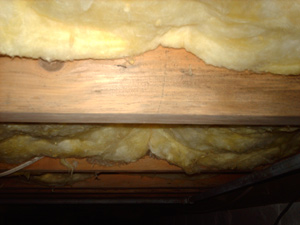In Business Since | License #
In Business Since | License #


Batts in the basement. Fiberglass insulation installed between basement ceiling joists won’t protect the basement from cold outdoor temperatures. Batts can’t stop air movement, either, so they don’t function well in this application.
The standard way to insulate the basement ceiling is to install fiberglass batt insulation between basement ceiling joists. Fiberglass batt insulation is inexpensive, readily available and fairly easy to install. No wonder this basement insulation strategy has been so popular.
Unfortunately, insulating the basement ceiling isn't a good way to improve your home's comfort and energy performance. Dr. Energy Saver can help inform you of better options to ensure energy efficiency in your home. Contact your local dealer to have an expert inspect your basement!
Basement ceiling insulation puts the basement space outside your home's thermal boundary. So in terms of temperature and energy performance, the basement is more like an outdoor space than an indoor one. During winter months, your basement will be uncomfortably cold. Hot water lines and ductwork located in the basement will also be subjected to these cold temperatures, diminishing the efficiency of your HVAC and hot water systems.
Another problem with basement ceiling insulation is that when fiberglass batt is used in this application, it does nothing to seal air leaks in floor above. So cold, damp basement air will move into the upstairs living space through numerous gaps, cracks and holes around ductwork, plumbing lines and electrical wires.
For the sake of comfort, energy efficiency and home value, it's better to insulate basement walls than to insulate the basement ceiling. Rigid foam insulation, installed against basement walls, protects your basement space from outdoor temperatures that are too cold or too hot. Unlike fiberglass insulation, rigid foam doesn't promote mold growth or lose its R-value when exposed to moisture. Rigid foam doesn't absorb moisture and won't be damaged in the higher humidity environment of a basement.
If your house already has basement ceiling insulation, don't worry. It can usually be left in place if you decide to have your basement walls insulated. Performing this energy-saving upgrade (along with air sealing around the perimeter of the basement) will transform a "problem" basement into a space that's an asset in terms of energy savings, interior comfort and added space.
Dr. Energy Saver wants to see the benefits of basement wall insulation in every home. Call a Dr. Energy Saver certified dealer or click below for basement insulation solutions!
Looking for a price? Get a no cost, no obligation free estimate.